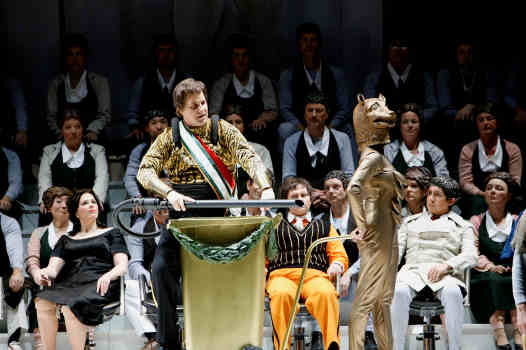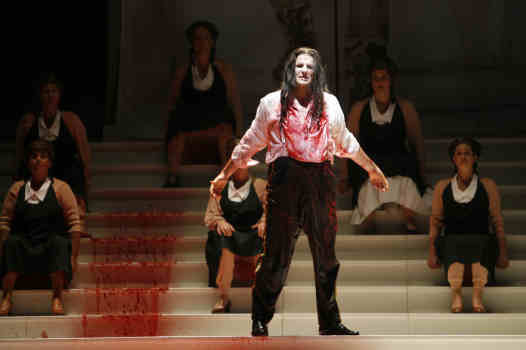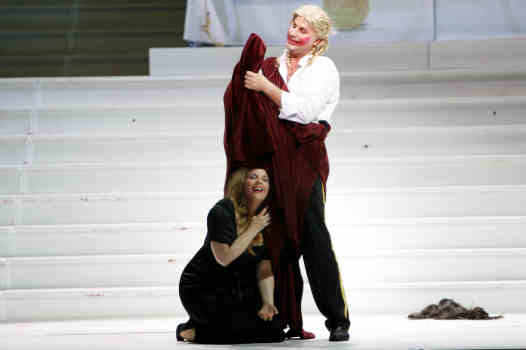Other Links
Editorial Board
-
Editor - Bill Kenny
-
Deputy Editor - Bob Briggs
Founder - Len Mullenger
Google Site Search
SEEN AND HEARD
INTERNATIONAL OPERA REVIEW
Wagner, Rienzi: Soloists and chorus of Theatre Bremen. Bremen
Philharmonic Orchestra. Conductor: Daniel Montané. Theater am
Goetheplatz,
Bremen, 4.4.2009. (JPr)
Wigs play a large part in this production. Powder-puffed, long curly ones are
worn by the nobles along with pin-stripe suits, Rienzi later sports a long
rock star wig and as his megalomania increases he receives the tributes of his
peers and the people in Act II Scene 1, like any tyrannical dictator who
delights in his chest full of self-awarded medals. Eventually he preens
himself and poses like a contestant at a Mr Universe pageant brandishing the
(flameless) flame thrower he carries on his back : his preferred method of
extermination.

Rienzi Act II
Rienzi is grandest of grand opera in five acts and was originally
intended for the Paris Opéra. It was too long when eventually staged at
Dresden in
1842 and Wagner knew it. He made some cuts himself, yet its length
still restricts performances. Wagner later considered the opera an
embarrassment and it has never been performed at the Bayreuth Festival. Most
versions heard today give us - as here - about three hours worth of music.

Rienzi Act III
In 1983, Nicholas Hytner and the English National Opera filleted Wagner’s
original concept even more than usual and their staging equated the story of
Rienzi with the rise of totalitarianism in the twentieth century. Originally
premièred in Bremen on 11th October last year, Katharina Wagner’s
production has returned for a further run of performances and it also updates
the story: here power literally goes to Rienzi’s head in the form of a
wig.
Rienzi’s vainglory demands that his baldness is covered by a toupée, even though
Mark Duffin looks like a young Frankie Howerd when wearing it. One of nobles
opposing Rienzi steals the wig instead of stabbing him in Act II and to
emphasise that vanity comes along with power, Act I Scenes 2 and 3 - in
which Adriano pledges support for Rienzi and later declares his love of
Irene - are all set in a hairdresser’s salon for the wig-fitting and Irene
comes along too to have her nails done. There was a nicely directed moment here.
Whenever Adriano tries to take Irene's hand, the off-stage trumpets that sound
out at the end of this scene, stop him from doing so every time.

Rienzi Act V
Fascism is never far away: the people salute Rienzi with arms aloft and index
fingers pointing up and by Act III the people are dressed more uniformly. The
men march with flame throwers in their hands ready to quell the rebellion and
the national socialist reference cannot be ignored here and elsewhere. At the
end, the people descend upon Rienzi and Irene in animal masks possibly
representing their original obeisance and when they realize that Rienzi has
finally ‘lost the plot’ after declaring that Rome is his ‘bride’, the
people tear the index fingers from Rienzi and Irene's gloved hands.
Perhaps less
explicable is why Cardinal Raimondo and his colleagues are all directed to
walk across the stage lifting their knees up high in a version of John Cleese’s
Ministry of Silly Walks. Katharina Wagner seems to have a good knowledge
of British comedy however because the triumphantly embarrassing dance that
Rienzi does at one point is clearly from Ricky Gervais’s character in The
Office TV programme.
Some moments obviously work better than others and the production probably
needs a second viewing to appreciate all of Katharina Wagner’s ideas. The Act II
‘pantomime’ does seem to go on forever but it also gives a new meaning to the
‘sacking of Rome’ as Romans in togas are swept away by Rienzi who is being led
on in a golden wheelie-bin : everything that has been discarded by the
Romans - their symbols of power perhaps - is collected up in a blue
rubbish sack.
Towards the end of Act II and onward to the end of the opera, the staging is
very powerful. The wide steps run with blood which mourning women fight a
losing battle to mop up and Rienzi is haunted by his burnt victims returning to
the stage as zombies. At the very end when the Cardinal excommunicates
Rienzi and things go downhill rapidly, Rienzi tries to turn himself into
the female effigy of Rome we have seen throughout the evening by putting a wig
on and smearing lipstick on his face. He has declared that he has God on his
side – and don’t all dictators who kill in the name of religion do exactly that?
He is quite mad now and addresses his own cloaked finger. He has supposedly been
rebuilding the Capitol but now its pillars are strewn around as his
world crumbles around him. An effigy of Rienzi is hanged but it is not clear
what happens to Adriano and Irene. By now Rienzi has torn off his wig(s)
off and has a bald pate but whether that was a stage accident or a rethink is
far from clear. The effigy still wears a curly wig as does Rienzi in the
programme photos so I was left a little puzzled by the ending of Katharina
Wagner’s otherwise thought-provoking interpretation.
The Theater am Goetheplatz in Bremen is not a large house seating only 800
and surprisingly it was not sold-out even though the first performances of
this production had been generally well-received. The Bremen Philharmonic played
well for their musical director, Daniel Montané: there was grandeur, drama
and much beauty from a score which shows that Wagner was not averse to recycling
some of his music for Tannhäuser and Die fliegende Holländer to name only
two of his later works. The chorus sang out lustily and acted with conviction
and the cast of principals seemed drawn from the ensemble of Oper Bremen
although surprisingly none of the three leading roles was taken by a German.
Karin Neubauer’s messenger of peace stood out with her cleanly sung contribution
in Act II and Franz Becker-Urban made suitably grave pronouncements as the
Cardinal.
Adriano was sung by the Russian, Tamara Klivadenko, who managed because of her
five o’clock shadow make-up to look more manly than is usually the case,
despite being costumed in bright tangerine. Her singing was ardent and
forceful for the Act III ‘Gerechter Gott’ and then later while seeking
revenge for her father death by Rienzi’s order. The American Patricia Andress
sang affectingly as the faithful daughter, Irene, and seemed to have excellent
vocal stamina, at least in this small house.
Mark
Duffin, another American, was Rienzi and he seemed a charismatic performer who
enthusiastically embraced Katharina Wagner’s idea of his character. He was quite
able to elicit empathy and drew us into his fate. He had a powerful and quite
baritonal heroic tenor which perhaps was not as lyrical as the religiosity of
his prayer ‘Allmächt’ger Vater’ demands, but was very well suited for his
earlier more stentorian outbursts of his rabble-rousing ‘Santo
spirito cavaliere!’
Finally a word about Bremen, a city that appears on this snapshot visit to
be at ease with itself (except on the day of a football local derby!) where
reliable trams glide you to and fro and where there are few cars because most of
the residents seem to have bicycles. People eat and drink in a smiling and
relaxed manner in the numerous beer gardens and cafes and there is no weekday
rush hour of stressed commuters rushing about. The supposed ‘global recession’
does not appear to be affecting this part of Germany, there are few CCTV
cameras, you can take beer glasses in to the cinema with you and buy a
Kalashnikov (should you have a reason to do so) for 400 Euros in a city-centre
gun and knife shop! But who knew that this is where Kellogg’s cornflakes
are distributed from? I cannot wait to go back there.
Jim
Pritchard
Rienzi is on at
Bremen's Theater am Goetheplatz. For more information, go to
http://www.theaterbremen.de.
Pictures courtesy of Theater Bremen
Back
to Top
Cumulative Index Page
